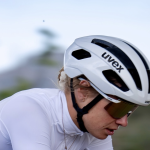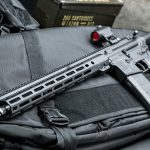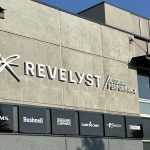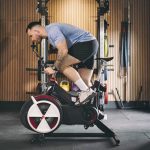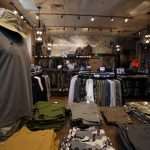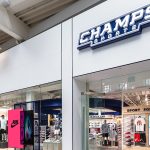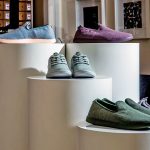The conversation at Nike, Inc. was very different in the fiscal first quarter this year compared to the same period last year as the company saw gross margins decline, expenses increase, and net income decline for the period ended August 31. Still, the company was able to exceed estimates on the top- and bottom-line and pointed to health in the underlying business as justification for their optimism in achieving their fiscal year objectives. To be fair, much of the impact on the SG&A line was due to difficult comparisons to the fiscal first quarter last year, when expenses benefited from a 10% decline in marketing spend, and the requirement this year to expense stock options, which reduced diluted earnings per share by 16 cents. Excluding the $40.8 million expense, net of taxes, related to the expensing of stock options, net income would have declined 3% for the period and diluted EPS would have increased 1% to $1.63 per share. But they also got a boost from a Converse settlement accrual benefit that added three cents to the bottom line.
Revenue for the quarter, which approached the $4.2 billion mark, did get a little more benefit this year from currency exchange rates, which added about two points of growth to the revenue line thanks to a weaker Dollar.
The company spent more time on their quarterly conference call this year talking about new initiatives and their other businesses than they have in the past, highlighting the gains in the subsidiary businesses and the success of projects like Nike+, Nike Pro, soccer, and the re-launch of Nike Air.
Heavy investments in these programs in Q1 were responsible for a 19% increase in demand creation spending during the quarter, which contributed to a 17% increase in SG&A expenses. FX rate fluctuations added about a point of growth to the SG&A line for the period, while the expensing of stock options contributed about nine points of the 15% increase in operating overhead for the quarter.
In the “Other” business, which is comprised of the Nike subsidiaries, operating income jumped 120% on a 21.2% increase in revenues for the first quarter. The increase added about $100 million in incremental revenues for the period, accounting for two points of the overall revenue gain for Nike, Inc.
The “Other” business, which includes Converse, Nike Golf, Cole Haan, Hurley, Nike Bauer Hockey, and Exeter Brands Group again easily outpaced growth in the Nike brand business, with all brands posting gains for the period. The Nike Bauer Hockey business, which has gone through a repositioning, posted the highest gains for the group with revenues increasing more than 50% for the quarter. Nike Golf was also called out as a key performer with a 34% increase for the period. Golf Apparel sales also “grew strongly” in Q1. The Hurley brand delivered “strong double-digit growth” and Converse revenues increased 22% on a wholesale equivalent basis. The Starter business in the mass retail channel was said to be up, but management said they did not expect to see dramatic increases in the channel this year. He sees the initiative really starting to make a big difference over the next two to three years.
The triple-digit increase in operating profits in the “Other” business was due in part to a $14.2 million pre-tax benefit due to a lower-than-expected final settlement related to a Converse arbitration ruling, and also saw upside from higher revenues and improved gross margins. Excluding the Converse settlement, operating income would have still been up 185% for the quarter.
Mark Parker, president and CEO of Nike, Inc., and Charlie Denson, president of the Nike brand, also highlighted gains in a number of initiatives under the core Nike brand business as well.
Mr. Parker said that soccer had grown “nearly 20%” over the last 12 months to $1.5 billion, making Nike the “leading soccer brand in the world.” While many would argue that the World Cup was less than a complete success for The Swoosh this time around due to the early exit of the U.S. team, Parker was apparently quite pleased with their progress in the category and their ability to connect with global “football” fans through their Joga Bonita campaign in partnership with Google.
Parker also pointed to the Jordan brand under the Nike umbrella, which generated double-digit growth in the first quarter after posting a 40% increase in the last fiscal year through May 2006. He said that Nike apparel revenues were up 21% for the latest quarter, driven by soccer, mens training, Nike Pro, womens fitness, adding about $120 million in incremental revenue for the quarter.
The other area that got a lot of attention was the Sport Culture business, which is where Nike houses its Metro product, including the low-profile footwear product. The Metro business was up more than 250% for the period and Parker estimates that it will be a $400 million business by fiscal year-end. The Skate business was also called out for its 250% increase in revenues in Q1.
| Nike, Inc. Fiscal First Quarter | ||||||
| Regional Operating Results | ||||||
| U.S. | EMEA | Asia/Pac | Americas | Other | Total | |
| Sales | $1,602 | $1,271 | $518.4 | $242.5 | $560.4 | $4,194 |
| Adj. Change* | n/c | 1.0% | 13.0% | 10.0% | n/a | 7.0% |
| Pre-Tax | $338.9 | $302.5 | $98.9 | $48.4 | $87.9 | $575.8 |
| Change | -1.8% | -8.3% | 8.2% | 9.0% | 120% | -13.0% |
| Backlog | 8.0% | 2.0% | 11.0% | -4.0% | n/a | 6.0% |
| Adj. Change* | n/c | 1.0% | 10.0% | 1.0% | n/a | 6.0% |
| * Adjusted for Currency Exchange Rates | ||||||
Nike brand growth in the U.S. region was said to be broad-based across most major wholesale accounts, while NikeTown stores posted a 2% comp store sales decline for the period compared to a 6% increase in fiscal Q1 last year.
Total U.S. retail sales grew 8% for the quarter. On the wholesale side, apparel revenues in the U.S. increased in high-single-digits, driven by double-digit growth in Nike branded performance apparel and brand Jordan. The decline in U.S. equipment sales in the period was said to be due to the transitioning of the socks and bags business from commodity styles to “more profitable performance positioning.”
U.S. first quarter pre-tax profits were down nearly two percent to $338.9 million, compared to $335.2 million in Q1 last year, due primarily to lower gross margins in footwear and the demand creation investments for the World Cup and Nike Air.
The EMEA region, which is comprised of Europe, the Middle East, and Africa, saw growth in most regions, but challenges remain in the U.K. and France. First quarter revenues for the EMEA region grew about 1% in currency-neutral terms, with footwear posting a 4% decline, apparel growing 8%, and equipment increasing 5% in currency-neutral terms. Management said the footwear decline was due to the weaker U.K. and France businesses offsetting gains elsewhere. The apparel growth stemmed from “strong sales” of replica football (soccer) product and “increased penetration” of performance apparel.
Pre-tax profits for the region were down more than 8% for the quarter to $302.5 million, compared to $330.2 million in Q1 last year, due primarily to lower GM and higher demand creation expenses that offset gains from currency fluctuations. Creating the slightly positive gain in revenues wasnt cheap as gross margin for the EMEA region declined for the quarter on a shift to lower margin product, increased discounts, and higher product input costs.
In Asia Pacific, China was again the primary driver for about 13% in currency-neutral growth, but most of the countries in the region were also up in double-digits for the quarter. China revenues were up more than 30% for the quarter, while Japan currency-neutral sales increased just over 2% for the period. NKE sees China revenues at a billion dollars by 2009. A-P currency-neutral footwear sales growth was pegged at about 12%, while apparel and equipment increased 13%.
Pre-tax profit improved 8.2% to $98.9 million from $91.4 million in the year-ago quarter, when profits jumped more than 44% versus the previous year. Gross margins and overhead spending were flat for the quarter.
The Americas region saw currency-neutral sales increase 10% during the period, roughly half the rate of growth in the year-ago period, while pre-tax profit grew 8.5% to $48.4 million from $44.6 million in fiscal Q1 last year. Most countries posted growth in the quarter, paced by strength in Argentina, Mexico, and Canada that was partially offset by “softer results” in Brazil.
There was some concern from analysts about the 15% growth in inventory at period-end versus the same time last year, but management said that most of it was due to more in-transit goods and quick-response product. Worldwide close-out inventories were said to be down about 6% at quarter-end, but they also mentioned that they had seen some inventory build at retail due to slower sell-through. They see inventory growth more in line with sales growth by the back half of the year.
>>> While Nike was not specific about the slowdown in sell-through, SEW hears that liquidation of marquee product, while not dead, is slower these days and even AF1s take a bit longer to push out the door thanks to the fashion shift
| Nike, Inc. | |||
| Fiscal First Quarter Results | |||
| (in $ millions) | |||



